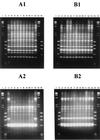Pandemic spread of an O3:K6 clone of Vibrio parahaemolyticus and emergence of related strains evidenced by arbitrarily primed PCR and toxRS sequence analyses
- PMID: 10655349
- PMCID: PMC86152
- DOI: 10.1128/JCM.38.2.578-585.2000
Pandemic spread of an O3:K6 clone of Vibrio parahaemolyticus and emergence of related strains evidenced by arbitrarily primed PCR and toxRS sequence analyses
Abstract
Vibrio parahaemolyticus O3:K6 strains responsible for the increase in the number of cases of diarrhea in Calcutta, India, beginning in February 1996 and those isolated from Southeast Asian travelers beginning in 1995 were shown to belong to a unique clone characterized by possession of the tdh gene but not the trh gene and by unique arbitrarily primed PCR (AP-PCR) profiles (J. Okuda, M. Ishibashi, E. Hayakawa, T. Nishino, Y. Takeda, A. K. Mukhopadhyay, S. Garg, S. K. Bhattacharya, G. B. Nair, and M. Nishibuchi, J. Clin. Microbiol. 35:3150-3155, 1997). Evidence supporting a hypothesis that this clone emerged only recently and is spreading to many countries was obtained in this study. Of 227 strains isolated in a hospital in Bangladesh between 1977 and 1998, only 22 strains isolated between 1996 and 1998 belonged to the new O3:K6 clone (defined by the serovar, the tdh and trh typing, and AP-PCR profiles). The O3:K6 strains isolated from clinical sources in Taiwan, Laos, Japan, Thailand, Korea, and the United States between 1997 and 1998 were also shown to belong to the new O3:K6 clone. The clonality of the new O3:K6 strains was also confirmed by analysis of the toxRS sequence, which has been shown to be useful for phylogenetic analysis of the members of the genus Vibrio. The toxRS sequences of the representative strains of the new O3:K6 clone differed from those of the O3:K6 strains isolated before 1995 at least at 7 base positions within a 1,346-bp region. A new PCR method targeted to 2 of the base positions unique to the new O3:K6 clone was developed. This PCR method could clearly differentiate all 172 strains belonging to the new O3:K6 clone from other O3:K6 strains isolated earlier. One hundred sixty-six strains belonging to 28 serovars other than O3:K6 were also examined by the new PCR method. The tdh-positive and trh-lacking strains that belonged to the O4:K68 and O1:K untypeable serovars and were isolated in three countries and from international travelers beginning in 1997 gave positive results. The AP-PCR profiles of these strains were nearly identical to those of the new O3:K6 clone, and their toxRS sequences were 100% identical to that of the new O3:K6 clone. The results suggest that these strains may have diverged from the new O3:K6 clone by alteration of the O:K antigens. In conclusion, this study presents strong evidence for the first pandemicity in the history of V. parahaemolyticus and reports a novel toxRS-targeted PCR method that will be useful in epidemiological investigation of the cases associated with the current pandemic spread.
Figures




References
-
- DiRita V J. Co-ordinate expression of virulence genes by ToxR in Vibrio cholerae. Mol Microbiol. 1992;6:451–458. - PubMed
Publication types
MeSH terms
Substances
Associated data
- Actions
- Actions
- Actions
- Actions
- Actions
- Actions
- Actions
- Actions
- Actions
- Actions
- Actions
- Actions
- Actions
LinkOut - more resources
Full Text Sources
Other Literature Sources

